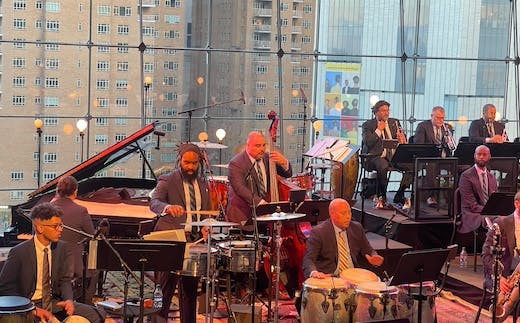Latin Jazz Is Latest Stop on Jazz at Lincoln Center Orchestra’s ‘Journey’
A running theme of the evening is how modern jazz and Latin rhythms interact and conjoin with each other to form a whole new music.

Jazz at Lincoln Center Orchestra
‘Journey Through Jazz: Part V’
Through April 13
Jazz at Lincoln Center, the Appel Room
Streaming at jazzlive.com
Jazz at Lincoln Center’s “Journey Through Jazz” series has now reached its fifth installment, all taking place in the smaller Appel Room rather than the big Frederick P. Rose concert space across the hall. On the whole, these are less ambitious but, from what I’ve seen, no less satisfying than the more formal orchestra concerts in the main room.
Most of the regular Jazz at Lincoln Center concerts focus on new music — or at least new takes on older music. The “Journey” programs feature less in the way of newly commissioned works and more history, which includes a lot of personal history and how it relates to the music.
This week, the subject is Latin jazz, and the man at the center is a longtime JALC bassist, Carlos Henriquez. He’s one of four hosts and musical directors, all of whom combine facts and details on the history of the music interspersed with their own back stories. The other three hosts are Latinx musicians of Mr. Henriquez’s approximate generation, though he would seem to be the youngest: trumpeter Michael Rodriguez, pianist Michael Rodriguez, and percussionist Bobby Allende.
Mr. Henriquez began with a rather illuminating illustration when he had the orchestra play the iconic Duke Ellington theme song, “Take the A Train,” in the familiar orchestration by composer Billy Strayhorn. This time, though, he led a five-piece Afro-Cuban rhythm section playing at the same time. Without making any changes to the arrangement, the two pieces fit together brilliantly, sounding like they were made for each other. That became a running theme of the evening, illustrating how modern jazz and Latin rhythms interact and conjoin with each other to form a whole new music.
Another common theme of the four presenters was the importance of family: all four hosts were first exposed to the music by their parents, through their record collections as well as live performances. Mr. Henriquez talked about how his older brother, an enthusiastic salsa dancer, would bring him along to ballrooms like the Copacabana, which was an illicit thrill unto itself for an under-age aspiring musician.
Most of the others credited their fathers, including the Rodriguez brothers; Michael Rodriguez offered an original composition in dedication to his father, “Gitmo’s Groove”: The senior Rodriguez had emigrated to America from Guantanamo Bay, Cuba.
Throughout the all-too-short evening, we heard historical examples of North American musicians creating music inspired by Latin rhythms, including Dizzy Gillespie’s “Manteca,” one of the national anthems of Latin jazz, as well as classic works by Cuban and Puerto Rican creators written in more of a jazz big band vein. Among the latter was “Tanga,” by the pioneering trumpeter and composer Mario Bauza, famously performed by Charlie Parker with Machito y su Orchestra at Carnegie Hall in 1949.
Overall, a lot of information was dispensed, many musical details in addition to historical ones, such as different variations on the clave rhythm — illuminating the subtle but important distinction between the 3-2 clave and the 2-3 clave. Robert Rodriguez also gave us different kinds of montunos, repeating patterns on the piano that he played in major and minor as well as various time signatures. Few in the audience would have been expected to remember everything; rather, the idea is merely to get a taste of what the music is all about, and who it was that gave it to us. On that note, it was gratifying to see a significant number of younger people in the house.
Along the way, the orchestra, with a guest tenor saxophonist, Dan Block, played other Latin classics like “Mambo Inn” and Ray Barretto’s “Cocinando,” as well as newer and original works like Michael Rodriguez’s “Rowdy Rod.” They also brought to light worthwhile older works that most of us in the crowd weren’t familiar with, like “El Mundo de Las Chicas (Blast Off)” by the saxophonist Aaron Sachs.
The “Journey Through Jazz” series is a highly enjoyable one, not least because of the venue. The Appel Room is world-renowned for its view of Columbus Circle, but its acoustics are even more remarkable — it is a whole new way to hear the JALCO orchestra. One can easily make out all three drummers, the orchestra’s regular, Obed Calvaire, and another guest, Marcos López, in addition to Mr. Allende, playing congas, bongos, and timbales. The closest thing to a drawback in the room is that half of the audience sits on higher chairs, and I was rocking so much in mine that I was afraid I’d fall over.
They saved Mr. Allende’s stories for last, perhaps because his were the most incredible and he had the biggest names to drop. At the age of 7, Mr. Allende and his brother were mentored by a legendary bandleader and timbales virtuoso, Tito Puente, who featured them on sets at the Corso Night Club. He also brought them with him to an appearance on “The Mike Douglas Show,” during which the other guest was the equally legendary Buddy Rich, who very warmly doted on this pair of percussion prodigies.
It was as rewarding as it was surprising to hear a nice story, for a change, about the man with the greatest beat and, infamously, the hottest temper and the shortest fuse in all of jazz.

